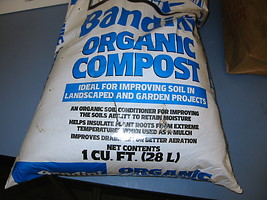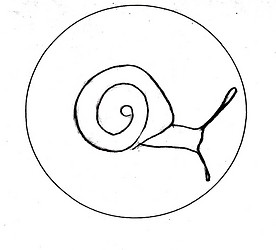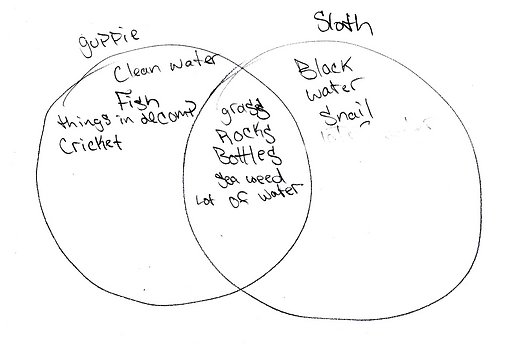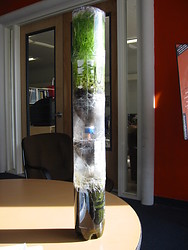Introduction
This is all about our ecobottle. It's an assignment that our teachers gave to us during science class. We made this ecobottle to see what would happen if we made an environment that would survive on its own. There are three different environments in the bottle. There is an aquatic environment, a decomposition environment, and a terrestrial environment
Procedure
Step 1:
- We gathered up 2 liter soda bottles and cut them at either the top, bottom, or both.
Step 2: *Aquatic*
- We put a few rocks into the bottom of the aquatic bottle.
- Then we filled the bottle up with about 1,250 milliliters of water.
- We added 2 elodea plants in the rocks, making sure they were secure and wouldn't float away.
Step 3: *Decomposition*
- We put some compost into the decomposition bottle.

© 2005 Kathryn Orzech
- We added a few sliced apples on top of the compost.
- Then we put in a snail, along with a piece of lettuce for it to eat.
Step 4: *Terrestrial*
- We put some soil into the terrestrial bottle.
- We planted 5.5 grams of grass seeds, 4 lima beans, a few radishes, and some basil seeds.
- Then we put 2 snails on top of the soil and seeds.
Step 5:
- We sealed our bottle with tape. The aquatic section on the bottom, terrestrial on top, and decomposition in the middle.
- We cut a tiny hole on the side of the aquatic section to get water out for testing the pH level and the temperature -- it is opened and sealed daily.

Hypothesis
The general hypothesis was that everything would die by the end of the 60 day observation period. We thought the snail would die within a week. We thought the grass would die by the third week, and the rest of the plants would die within four weeks.
Terrestrial
In the terrestrial section we predicted that if we planted grass seeds, they probably won't grow that much. We also thought the two snails in this section would die on the third day due to the lack of food provided to them.
Decomposition
In the decomposition section we predicted that each day the apple slices would get darker until they completely molded and disappeared. We also predicted that the snail in this area would die within five days as well.
Aquatic
In the aquatic level we predicted that there would be spreading algae by the day, the first day it would stay in one place, second day it would spread a little bit, third day would spread even more, forth day it would float to the top, the fifth day it would begriming growing profusely, and so on throughout the course of 60 days.
Observation
Date - 9/30 Time - 9:50
- General Impression - The water looks like coffee because of the dirt from terrestrial and it smells really bad. Overall the whole bottle is doing fine. We are changing the water now. The bottle isn't completely sealed yet.
- Terrestrial - There is grass growing and mold everywhere, even under the dirt. There are two snails and they might be dead, we can't see them. It is looking ok, but it's muddy.
- Decomposition - There are rotting apples and lettuce. No mold, and one snail.
- Aquatic - The aquatic was looking nasty and dirty but it's fine now because we changed the water. The water now is some what clear. There are no animals in this section. The plants are doing fine and look the same.
Date - 10/4 Time - 11:00
- General Impression - Moldy, Dirty and Smelly. The water in Aquatic is practically black!
- Terrestrial - I'm pretty sure that the three snails are dead. There is about 2-3 inches of grass now. The apple tree is sprouting! Maybe...
- Decomposition - The apples have molded and shrunken.
- Aquatic - The water is BLACK and raised about 1 1/2 inches. We put a coffee filter in above the aquatic section. It is brown and soggy now.
Date - 10/6 Time - 10:40
- General Impression - Smells bad, dirty, and moist.
- Terrestrial - The grass has grown to be about 3 inches tall. There are some radishes growing as well. All of our snails are dead. :-(
- Decomposition - The apples are disintegrated. There is mold on the soil and some on the lettuce.
- Aquatic - The water is rising, almost touching the coffee filter. The water is so black you can't see any of the plants.
Date - 10/7 Time - 10:45
- General Impression - Smelly! Dirty.
- Terrestrial - There is some kind of plants growing on the side and it is not an apple tree They look like lima beans. We just found out that two of the snails are alive. The grass looks the same.
- Decomposition - The apples are molded, and the lettuce isn't visible.
- Aquatic - We took out 400 milliliters of water. The coffee filters are falling. The water is still black but you are able to see the rocks.
Date - 10/10 Time - 10:37
- General Impression - Very moist and smelly.
- Terrestrial - The grass is about 5 inches tall. There is one snail climbing on the wall. The lima bean plants are about 3 inches tall, and have two beans growing off of them.
- Decomposition - The apples are molded and the lettuce is gone. The soil is really moldy.
- Aquatic - The water is still jet black. We just watered it so it's slowly getting higher, and you can no longer see the coffee filters.
Date - 10/11 Time - 11:02
- General Impression - Smelly, dirty, and wet.
- Terrestrial - Grass hasn't really grown since the last observation. One of the snails for sure is still alive. The lima beans are starting to sprout.
- Decomposition - Moldy, everything is dead. The apples have wrinkled up and are about the size of a dime.
- Aquatic - The water looks the same but you are able to see the rocks covered with mold through the side.
Date - 10/18 Time - 10:46
- General Impression - Crowded.
- Terrestrial - The grass is now touching the roof of the ecobottle on one side. We can't find the snail.
- Decomposition - The molded apples are covered with soil due to the ecobottle falling over in transit. There is soil all up the side of the bottle.
- Aquatic - The water level has gone down a bit and is now about 4 inches deep. It isn't as black and you are able to see little leaves floating around.
Date - 10/21 Time - 9:45
- General Impression - Messy, looks like it's been through a lot.
- Terrestrial - The grass grew about in inch and it looks really crammed. The lima bean plants look the same, they haven't really grown. The snail is for sure alive, it is on a blade of grass.
- Decomposition - There's one piece of rotting apple left that you can see. The rest of everything in this section is gone besides the soil.
- Aquatic - The plant that we put in at the begriming is completely destroyed and is floating around in a bunch of different pieces. The water is about the same color and if it has changed it only got lighter.
Date - 10/27 Time - 11:05
- General Impression - Smelly.
- Terrestrial - The grass has gotten really tall, it's about 10 inches tall. The lima bean plants are blended in with all the grass so you cannot really see them.
- Decomposition - It looks like there is only soil left. The apple slice that was left is now gone, most likely buried beneath the soil.
- Aquatic - There is some type of algae or mold growing on the top of this section, it is lime green and looks slimy. The water is once again getting darker.
Date - 10/29 Time - 9:40
- General Impression - Messy, smelly, and moldy.
- Terrestrial - The grass is curling at the top because it is so tall. You can see the top of the lima bean plant and it is about 4 inches tall.
- Decomposition - There is a lot of white mold growing on the side. You can't really see much more than that because the walls are foggy and covered with soil.
- Aquatic -The green algae is spreading and looking thicker. The water looks the same.
Date - 10/31 Time - 10:11
- General Impression - Smelly, moldy and overgrown.
- Terrestrial - The grass has grown a lot, it's all touching the top of the bottle and folding over. The soil is everywhere, all up the grass, and you are unable to see the lima beans again.
- Decomposition - This section doesn't look any different and you cant really see it anyway.
- Aquatic - The slimy algae is spreading tremendously and is begriming to fall into the water. The water hasn't moved because we haven't watered the bottle recently.
Date - 11/3 Time - 11:07
- General Impression - Dirty.
- Terrestrial - The snail is on a blade of grass very close to the top, it is hard to tell if it is alive or dead. The grass looks very healthy and green.
- Decomposition - You are able to see through the plastic now and it hasn't changed. It grew more greenish mold, but that's all.
- Aquatic -The water level has been raised bandit is covering the algae. Some of the water is oozing through the tape. You cannot see the rocks anymore because the water has gotten so dark.
Date - 11/4 Time - 9:32
- General Impression - Green and Brown
- Terrestrial - There is a lot of grass. Soil is everywhere. From what we can see of the lima beans we think they are dying. The snail isn't in the same place as before, so we know it is alive.
- Decomposition - The walls are wet and moist. There is a lot of mold on the soil, you cannot even see the color brown from the top.
- Aquatic - There is a lot of green slimy algae on the top growing on the plastic of the bottle. Water is still slowly coming out of the tape and is really thick and nasty. There is mold on the bottom, mostly on the rock and leaves floating around, there are not as many leaves as before so some of them are probably laying on the rocks.
Date - 11/7 Time - 9:33
- General Impression - Smelly and very dirty.
- Terrestrial - Dirty and soily. The lima bean plants are gone - well, they are hidden in the grass and not visible. The grass is really tall and green. Nothing looks like it's dying from this point of view.
- Decomposition - This section never really changes. All you can see is greenish blue fuzzy soil that is everywhere, and soil that takes up about a quarter of the is section.
- Aquatic - The water is overflowing and when it tips it goes in to the other sections. All you can see is water and some of the algae on the top which is actually a half an inch into the water now.
Date - 11/17 Time - 11:01
- General Impression - Dirty. Nasty.
- Terrestrial - Overgrown like crazy. The soil is still everywhere. The lima bean plants are almost dead and have fallen over. From what we can see they look about 6 inches tall.
- Decomposition - The whole section is turning gray. Nothing has changed, it's pretty boring.
- Aquatic - The oozing hasn't stopped, it's only gotten worse. The tape looks fuzzy. The water is really dark and we cant really observe anything, besides the blackness of the water.
Date - 11/21 (Last Day) Time - 9:47
- General Impression - Almost gone. Overgrown. Ugly.
- Terrestrial - The grass has gotten even taller, it doesn't even fit. The snail is on a blade of grass (once again) and is really big, it's about the size of an eraser on a pencil.
- Decomposition - Lots of mold. It's pretty nasty and isn't level. It's very wet and the mold is very fuzzy.
- Aquatic - There is a lot of green slimy thick mold on the top. The water is black and has specks of stuff everywhere. The leaves are still floating around the bottom and the rocks have a lot of mold on them. It looks like a swamp but worse.
Analysis:
Overall our ecobottle changed in a lot of ways. The water went from being like crystal clear to pitch black. It was one of the grossest, smelliest things ever. There was a lot of grass growing right away. The grass grew so tall we couldn't find the snail in the grass. The only way we could find it was if we watered the bottle so it would come out. The snail grew really big and all the fruit in the decomposition area went away by the end.
 View SlothOrganisms.xls Graph of what lived and what died.
View SlothOrganisms.xls Graph of what lived and what died.
 View SlothTempThruTimeGraph.xls Graph of aquatic temperature over time.
View SlothTempThruTimeGraph.xls Graph of aquatic temperature over time.
- What animals thrived in your ecobottle? By the end of our experiment, the only animal that had survived in our ecobottle was one snail, living in the terrestrial section.
- Why do you think these animals thrived? We think our snail survived and grew bigger because we planted plenty of plants for it to eat. For that period before the plants grew, we put in lettuce for it to eat.
- What plants thrived in your ecobottle? Our grass grew very well and tall. I'm proud of our grass! Beans and radishes sprouted, the algae did great, and the elodea stayed alive but didn't do very well.
- Why do you think these plants thrived? We planted a LOT of grass seeds, watered our bottle often, and kept our bottle in the sun during the day.
- What animals died quickly in your ecobottle? Our snail that was living in the decomposition section died quickly.
- Why do you think these animals died? Our snail in the decomposition died due to lack of food. I think if we put more food inside for it to live on, it would have survived a bit longer.
- What plants died quickly in your ecobottle? None of the plants that we planted died. The elodea plants didn't die, but if we kept them in our ecobottle any longer, it might have.
- Why do you think these plants died? Well, they didn't!
- What would you do differently next time to improve the long-term survival of the plants and animals you selected? We would add more animals to the bottle so it'll be more interesting to observe. We also would put in better filters between each section, and more rotting food in the Decomposition section.
Conclusion
In conclusion, we learned that it is possible to have a living system inside another container, just like the biosphere 2, but smaller. We didn't learn much more than that. In the bottle itself, we learned that we really didn't need to water it as much as we did. In fact, it was better if we watered it only once every 2 weeks or so so the water wouldn't get all gross and dirty after watering it. We think we should have put screens in the caps and maybe added less soil. We would also only water it once every other week instead of once a week and start out with less water in the aquatic section. In the end, we decided that we'd never do this again, it was fun while it lasted, but in our opinion all those animals and organisms would be much better off on their own, un-messed with.








 Go to quick links
Go to quick search
Go to navigation for this section of the ToL site
Go to detailed links for the ToL site
Go to quick links
Go to quick search
Go to navigation for this section of the ToL site
Go to detailed links for the ToL site